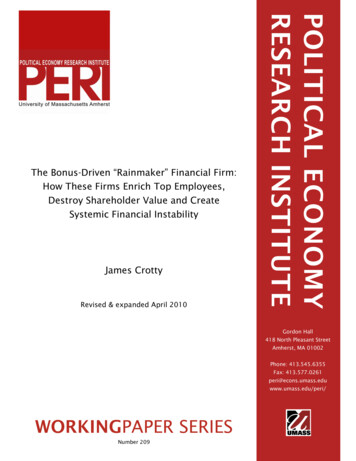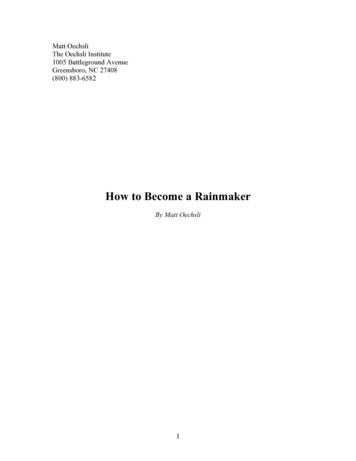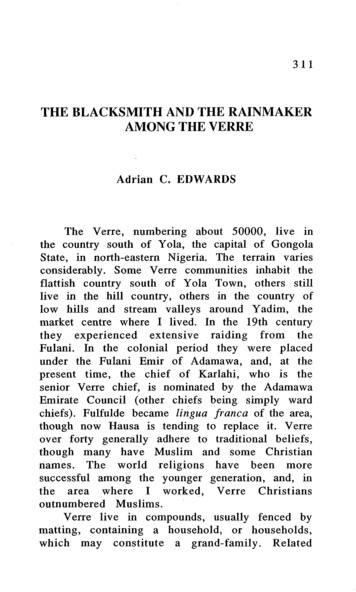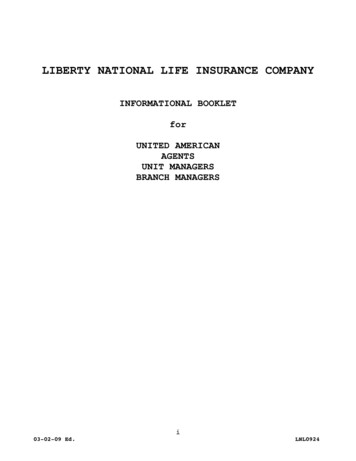
Transcription
James CrottyRevised & expanded April 2010POLITICAL ECONOMYRESEARCH INSTITUTEThe Bonus-Driven “Rainmaker” Financial Firm:How These Firms Enrich Top Employees,Destroy Shareholder Value and CreateSystemic Financial InstabilityGordon Hall418 North Pleasant StreetAmherst, MA 01002Phone: 413.545.6355Fax: /WORKINGPAPER SERIESNumber 209
The Bonus-Driven “Rainmaker” Financial Firm:How These Firms Enrich Top Employees, Destroy Shareholder Value and CreateSystemic Financial InstabilityJames CrottyUniversity of Massachusetts, AmherstApril 2010First Draft: October 2009I am grateful to Derek Jaskulski, Iren Levina, Jennifer Taub and especially Jerry Epsteinand Rob Parenteau for helpful comments, to Iren Levina for outstanding researchassistance, and to the Economics Department’s Sheridan Scholars program for researchsupport.1
AbstractWe recently experienced a global financial crisis so severe that only massive rescueoperations by governments around the world prevented a total financial market meltdownand perhaps another global Great Depression. One precondition for the crisis was theperverse, bonus-driven compensation structure employed in important financialinstitutions such as investment banks. This structure provided the rational incentive forkey decision makers in these firms (who I call “rainmakers”) to take the excessive riskand employ excessive leverage in the bubble that helped create the bubble and make thecrisis so severe. This paper presents and evaluates extensive data on compensationpractices in investment banks and other important financial institutions. These data showthat rainmaker compensation has been rising rapidly, is very large, and has asymmetricproperties that induce reckless risk-taking. Since boom-period bonuses do not have to bereturned if rainmaker decisions eventually lead to losses for their firms, since largebonuses continue to be paid even when firms in fact suffer large losses, and sincegovernments can be counted on to bail out the largest financial firms in a crisis, it isrational for rainmakers to use unsustainable leverage to invest in recklessly risky assets inthe bubble. A review of the modest literature on financial firm compensation practices ingeneral and those of investment banks in particular demonstrates that the giant bonuses ofthe recent past are not appropriate returns to human capital – they are unjustified rents.The paper discusses possible answers to the challenging questions: what is the source ofrainmaker rents and how are they sustained over time? Answers to these questions canhelp guide debates over the appropriate regulation of financial markets. They are alsonecessary inputs to the development of an adequate theory of the “rainmaker” financialfirm that can help us understand how these firms were able to maximize thecompensation of their key employees through policies that destroyed shareholder valueand created systemic financial fragility. To my knowledge, no such theory currentlyexists.Key Words: bonuses; investment banks; leverage; financial crisis; perverse incentivesJEL Codes: G01; G24; G102
I. IntroductionIt is now universally agreed that the US and global economies have experiencedtheir worst financial crisis since the 1930s, one that contributed to a severe globaldownturn. This financial crisis has led to massive government bailouts around the world.There is debate about the respective roles of the real and financial sectors in the creationof this crisis, but it is undeniable that financial markets were at least a major contributorto the crash. From a US-centric perspective, it is clear that the evolution of financialmarkets since the end of the 1970s led almost inevitably to a crisis moment such as this.In response to economic problems and political pressure in the 1970s and very early1980s, the US government began to accelerate an ongoing process of financial marketderegulation. A combination of deregulation and fast-paced financial innovation led to aseries of financial crises both in the US and elsewhere. These crises were met bygovernment bailouts, which restored vitality to financial markets, but also created severemoral hazard – an increasingly assured belief among leaders of financial institutions thatthe government would always intervene to limit the depth and duration of any financialdownturn. Thus, it was safe for them to take increasing risk and use increasing leverageto increase profit and maximize the compensation of their key people – hereafter knownas “rainmakers” – during periods of financial market booms. As a result, crises becamemore threatening, bailouts bigger, and subsequent financial booms more vigorous. Theterm rainmaker is usually taken to mean those who can generate high sales for the firm. Iuse it here to denote all key people in financial firms who are responsible for generatinghigh revenue and profit. 1 It thus includes top executives, traders and sales people, wealthmanagers, and M&A and IPO teams.More important, these cycles were imbedded in a long term trend in whichfinancial markets grew ever larger relative to the real economy, and global financialmarkets became increasingly integrated. Financial profits as a share of total corporateprofits, which was about 10% in the early 1980s reached 40% in the mid 2000s. In 1981,US private debt was 123 per cent of gross domestic product; by the third quarter of 2008,1Standard and Poor’s made the following comment in a report on investment banking: “The competitiveenvironment also is such that the various firms are always competing for the most talented employees: the“rainmakers”” (Standard and Poor’s 2009, p. 28).3
it was 290 per cent. In 1981, household debt was 48 per cent of GDP; in 2007, it was 100per cent.The biggest rise in indebtedness took place in the financial sector itself.Thegross debt of the financial sector rose from 22 per cent of GDP in 1981 to 117 per cent inthe third quarter of 2008. This rapid rise in financial firm borrowing fueled the financialboom. Borrowed funds were used to bid up asset prices, creating higher collateral valuesthat in turn enlarged the borrowing capacity of speculators. This paper focuses specialattention on the giant investment banks, whether independent or part of financialconglomerates, because they were the main source of the financial innovations that wereat the center of the recent global financial crisis and because they were the most powerfulfinancial institutions whose destructive behavior was shaped by the perversecompensation systems discussed at length in the paper. According to the Fed’s flow offunds data, the liabilities of the investment banking sector rose from 548 billion in 1995to 3 trillion in 2007, an annual growth rate of 16%. Between 2002 and 2007 alone,liabilities grew by 138%. (In the midst of the crisis in the first quarter of 2009, liabilitiesfell to 1.8 trillion.) Fast growth in borrowing led to increased leverage ratios and thusgreater financial firm risk. But it also led to rising revenues and profit. Given thecompensation schemes used in many large financial firms, rising revenues and profit leadto even more rapid rises in rainmaker bonuses. Rising leverage thus provided a majorsource of funding for the spectacular increase in the compensation of top bank.The rising relative size of financial markets created structural systemic financialfragility in which the financial claims on real-sector cash flows became ever largerrelative to the cash flows themselves. Financial claims also became more complex.Mortgages were rolled into mortgage backed securities, which were sliced and diced intocollateralized debt obligations. Credit default swaps were then written on collateralizeddebt obligation tranches. The extreme complexity of structured financial products madethem non-transparent or opaque, which made it easy for markets to substantiallyunderestimate their risk in the bubble. Before 2008 it was not clear when this processwould end, or what the end game would look like. But it was clear, at least to some, that4
the entire process had become unsustainable. 2 By the fall of 2008 it was apparent toeveryone that the global financial system was on the verge of collapse.As this paper will show, rainmakers received huge bonuses by taking excessiverisk and using dangerous levels of leverage, and they did not have to return these bonuseswhen their risk-seeking caused their firms and the entire financial system to crash.Indeed, they continued to receive exorbitant bonuses even in the downturn. Theasymmetry in rainmaker compensation schemes combined with deregulation anddestructive financial innovation made the outbreak of a serious crisis almost inevitable.(For an analysis of the financial causes of the recent crisis, see Crotty 2009.) 3Financial institutions infected by perverse incentives include independentinvestment banks, large commercial-bank centered financial conglomerates (that includein-house investment banks, hedge and private equity funds), hedge funds, private equityfunds, institutional investors such as mutual funds, general and monoline insurancecompanies and ratings agencies. Perverse compensation incentives led ratings agencies tohide the buildup of excessive risk throughout the system by giving safe ratings toextremely dangerous financial products. 4Among the financial institutions with perverse incentives, investment banks –whether independent or part of financial conglomerates - played a crucial role in creatingrecent boom-bust cycles and the secular expansion of financial markets in our era. Theywere the source of most of the financial innovations - such as mortgage backed securities,collaterized debt obligations of various kinds and credit default swaps - that helped createthe crisis. Investment banks were also at the center of the leverage creation process. Halfof the spectacular rise in US investment bank’s return on equity in the four years leading2See for example Crotty 2007. Sitglitz 2010b includes himself along with Noriel Rubini, George Soros,Stephen Roach, Robert Shiller and Robert Wescott as economists who warned of an impending financialcrisis.3Paul Krugman argued that “there was nothing accidental about the crisis.”From the late 1970s on, the American financial system, freed by deregulation and a politicalclimate in which greed was presumed to be good, spun ever further out of control. There wereever-greater rewards — bonuses beyond the dreams of avarice — for bankers who could generatebig short-term profits. And the way to raise those profits was to pile up ever more debt, both bypushing loans on the public and by taking on ever-higher leverage within the financial industry.(Krugman 2010)4In April 2007, one analyst at Standard and Poor’s said their ratings model “did not capture “half” of adeal’s risk We should not be rating it.” A colleague responded: “We rate every deal. It could bestructured by cows and we would rate it” (Moran 2009, p. 94).5
up to the crisis was generated by higher leverage rather than smart investing, efficientinnovation or even boom-induced capital gains on trading assets. 5Compensation practices differ across financial market segments, but they all sharethe characteristic that their rainmakers can maximize their compensation over time bytaking excessive risk in the boom. 6 A Financial Times editorial put the problem asfollows:By paying huge bonuses on the basis of short-term performance when negativebonuses are impossible, banks create huge incentives to disguise risk-taking asvalue creation. Moreover, if bankers are rewarded for pursuing risky strategiesthat appear highly profitable for an extended period and then blow up, it is otherswho pay the costs. Given the extreme difficulty for outsiders, even topmanagement, of monitoring the true risks being run, the result is a disaster justwaiting to happen. But, of course, top management is itself part of the problem: it,too, has huge incentives to bet the bank. (“Curbing the excess of bankers’ pay,”March 7 2008)A Wall Street Journal article expressed a similar understanding of the dangers ofperverse incentives.Bankers' pay must be regulated. The industry's one-way incentive structures haveled bankers to run amok with other people's money -- contributing to the chaos infinancial markets. When their bets pay off, bankers and traders carry homemassive bonuses. When the bets crater, they don't hand those bonuses back. Ifbankers aren't forced to face the full consequences of their folly, the current messwill be repeated. (“Why Banks Need Pay Fix Compensation Practices Lack Teethto Penalize Traders Who Lose Big,” March 11, 2008).Alan Blinder stated the problem this way: “From the point of view of thecompanies’ shareholders [the rainmaker compensation scheme] is madness.” Using acoin flip analogy in which heads represents a risky decision that pays off and tails onethat leads to losses, he says that from the shareholders’ perspective:the gamble looks like: Heads, we get a share of the winnings; tails, we absorbalmost all the losses. The conclusion is clear: Traders and managers both want toflip more coins – and at higher stakes than shareholders would if they had anycontrol, which they don’t. The source of the problem is quite simple: Give smart5“Higher leverage fully accounts for the rise in UK banks’ returns on equity up until 2007” (Alessandri andHaldane 2009, p. 8).6A detailed description of perverse incentive practices in different financial markets is provided in Crotty2008.6
people go-for-broke incentives and they will go for broke. Duh. (Wall StreetJournal, "Crazy Compensation and the Crisis” May 28, 2009) 7Diamond and Rajan argue that bonus driven compensation schemes:gave traders an incentive to take risks that were not recognized by the system, sothat they could generate income that appeared to stem from their superiorabilities, even though it was in fact only a market-risk premium. The classic caseof such behavior is to write insurance on infrequent events, taking on what istermed “tail” risk. If traders are allowed to boost their bonuses by treating theentire insurance premium as income instead of setting aside a significant fractionas reserve for an eventual payout, then will have an excessive incentive to engagein this sort of trade. (Cited in Rajan 2009b, p. 3)Nobel laureate George Akerlof and Rachel Kranton note that in recent decadeseconomists have argued that employees would “work harder and make better decisionsunder a ‘pay-for-performance’ system,” a theory that “became popular in boardrooms especially since it was an influential argument for increasing the pay of the chiefexecutive and top officers.” They suggest several reasons why the argument is specious.First, top management does not know what impact employee decisions will have on thelong-term performance of the firm: “superiors do not hold the same information [asrainmakers] and the results play out years later.” Second, the risk-return profile of thefirm is not independent of its compensation system: a bonus system will “attract preciselythose who are willing to take on more risk.” Third, “to get their [bonuses], employeesmay manipulate the system, against the interests of those who set up the incentives”(Financial Times, “It is time to treat Wall Street like Main Street, February 25, 2010). 8Though almost everyone now acknowledges that perverse compensationincentives were a major cause of the financial crisis, there has been surprisingly littleserious academic analysis of the existence and reproduction of dysfunctionalcompensation practices in financial institutions. Why and how did these practices evolve?What explains the premiums paid to top financial employees relative to those working inother industries? Are rainmaker compensation practices consistent with the reproductionof financial firms over the long run? Are they compatible with the interests of7As explained below, there are good reasons to believe that shareholders would not restrain risk-taking inthe boom even if they could.8The last point makes the dubious assumption that rainmakers’ superiors want to maximize long-termreturn.7
shareholders? Are they justified by exceptional long-term creation of shareholder value?Can it be shown that rainmakers have superior human capital as compared to top earnersin other industries who make much less than they do? Or are rainmaker premiums rents,achieved not as a just reward for exceptional productivity but because rainmakers havethe power to extract pay far in excess of their long-term contributions to shareholdervalue? If so, what is the source of this power?The answers to these questions have important implications for the theory offinancial firms and of financial markets, as well as for the debate over whether financialmarkets are “efficient” with respect to the setting of financial security prices and theallocation of real resources across competing uses. Answers to these questions can alsohelp us better understand whether the rapid rise in inequality experienced over the pasttwo decades has been driven by widening efficiency and productivity gaps amongemployees or, rather, has been primarily determined by relative power relations.We need answers in order to inform the current debate about government regulation offinancial firm compensation. (Not surprisingly, rainmakers do not think tighter regulationa good idea.) Strong regulation of large financial institution compensation schemes is anecessary component of effective regulation, but, by itself, it cannot force financialmarkets to operate in the public interest. A more complete set of proposals for regulatoryreform is suggested in Crotty and Epstein 2009.We know both the origin of, and the justification for, bonus-dominatedcompensation schemes in investment banking. Most investment banks began as limitedpartnerships. As such, the firm was solely devoted to maximizing the income of theirrainmakers – the bank’s partners. Financial markets tend to be more volatile than mostnonfinancial markets. The bonus system - in which a modest base salary is supplementedby a large but variable bonus whose size depends upon bank and individual performancehas the distinct advantage that, if adequately elastic in the downturn, it can quickly andsubstantially cut compensation costs in down markets to protect the integrity of the firmand shareholder profit. This is the primary justification used to defend the bonus-basedcompensation scheme used in financial markets. Though bonuses would rise substantially8
in financial market booms, they were supposed to also fall dramatically when marketscrashed. 9The next section demonstrates that the bonus system actually used by largefinancial firms was qualitatively different than the ideal bonus system just described.Moreover, in recent years the practice of granting investment bank rainmakers multipleyear guaranteed bonuses and retention bonuses (ostensibly designed to prevent toprainmakers from moving to other firms) has blossomed. Guaranteed and retentionbonuses also demonstrate that modern bonus-based compensation schemes are typicallynot used for their original purpose because they do not decline with revenue and they arepaid without regard to employee or firm performance. “A guaranteed bonus might strikemany people as a contradiction in terms. But on Wall Street, banks have become so eagerto lure and keep top deal makers and traders that they are reviving the practice of offeringironclad, multimillion-dollar payouts guaranteed, no matter how an employee performs.”Even firms kept on life support by government funds continue to engage in this practice.In early 2009, Citigroup, which was on government life-support after its disastrouscollapse, lured senior derivatives traders, a category of employee responsible forexcessive risk taking in the boom, with multimillion dollar, multiyear guaranteedbonuses. Government-owned AIG will pay 281 million in guaranteed retention bonusesto key members of its sales force in 2008 (Dash 2009). 10The structure of the paper is as follows. Section II presents and evaluates data onrainmaker compensation in giant investment banks. The data show that rainmakercompensation is very large, and that its asymmetric properties generate strong incentivesfor excessive risk taking in financial booms. Section III reviews the modest literature oncompensation in financial firms in general and investment banks in particular. Itdemonstrates that rainmaker premiums have been quite large in recent decades and thatthey can not be explained as returns to human capital – they are rents. Section IVdiscusses possible answers to the difficult question: where do the rainmaker rents come9It was also believed that a bonus system would induce partners to work as hard as they could, since eachwould get a piece of the extra revenue she generated, and that it would induce cooperation among partnersbecause each partner shared in the fruits of every other partner’s labor.10In announcing plans to regulate bonuses, French President Sarkozy stated that “guaranteed bonuses are tobe banned” (Financial Times, Sarkozy tightens bonus rules,” August 26, 2009).9
from and how are they sustained? The final section summarizes conclusions from thisanalysis.II. Rainmaker Compensation Schemes: The Primacy of BonusesBonuses in Boom and BustThe most authoritative data on bank compensation practices in the recent boomand crisis were collected by New York State Attorney General Andrew Cuomo, whopublished a report on the subject aptly titled “No Rhyme or Reason: The ‘Heads I Win,Tails You Lose’ Bank Bonus Culture” (Cuomo 2009). His summary of the report’sfindings is so important that I quote from it extensively.Bonuses are supposed to rise when revenues rise, but then fall quickly whenrevenue declines sharply in downturns in order to sustain profit and protect shareholderinterests in a very volatile business. That is the rationale for paying top employees such ahigh percent of their compensation in bonuses rather than as fixed salaries. Topemployees on Wall Street “typically make 90% or more of their compensation in yearend bonuses (Wall Street Journal, “Bank Bonus Tab: 33 Billion Nine Lenders That GotU.S. Aid Paid at Least 1 Million Each to 5,000 Employees,” July 31, 2009). And since,in the years leading up the crisis, “most bankers could expect to receive anywhere from60-90 per cent of their bonuses in cash,” the bonus system created powerful incentives totake risk now and not worry about what problems this might cause for the firm later(Financial Times, “Bonus culture remains strong,” February 10, 2010). But Cuomoconcludes that “even a cursory examination of the data suggests that in these challengingeconomic times, compensation for bank employees has become unmoored from thebanks' financial performance. Thus, when the banks did well, their employees were paidwell. When the banks did poorly, their employees were paid well. And when the banksdid very poorly, they were bailed out by taxpayers and their employees were still paidwell.” He continues:Bonuses and overall compensation did not vary significantly as profitsdiminished. An analysis of the 2008 bonuses and earnings at the original nineTARP recipients [of 125 billion in government bailouts] illustrates the point.Two firms, Citigroup and Merrill Lynch suffered massive losses of more than 27billion at each firm. Nevertheless, Citigroup paid out 5.33 billion in bonuses andMerrill paid 3.6 billion in bonuses. Together, they lost 54 billion, paid out10
nearly 9 billion in bonuses and then received TARP bailouts totaling 55 billion.For three other firms - Goldman Sachs, Morgan Stanley, and JP. Morgan Chase 2008 bonus payments were substantially greater than the banks' net income.Goldman earned 2.3 billion, paid out 4.8 billion in bonuses, and received 10billion in TARP funding. Morgan Stanley earned 1.7 billion, paid 4.475 billionin bonuses, and received 10 billion in TARP funding. JP. Morgan Chase earned 5.6 billion, paid 8.69 bil1ion in bonuses, and received 25 billion in TARPfunding. Combined, these three firms earned 9.6 billion, paid bonuses of nearly 18 billion, and received TARP taxpayer funds worth 45 bil1ion (Cuomo 2009,pp. 1-2, emphasis added). 11Losses reported by Merrill totaled 35.8 billion in 2007 and 2008, enough to wipeout 11 years of earnings previously reported by the company. Yet for the 11-year periodfrom 1997 to 2008, Merrill’s board gave its chief executives alone more than 240million in performance-based compensation (New York Times, “After losses, a move toreclaim executives’ pay,” February 22, 2009). John Thain took over as Merrill’s CEOafter Stanley O’Neil had been relieved of his command (with a 161 million goldenhandshake). Though he worked only one month in 2007, his total compensation that yearwas valued at 83 million (Prins 2009, p. 84). 12Taking a full-cycle view, Cuomo shows that while compensation did accelerate inthe boom, it failed to shrink in line with revenue in the crash. Indeed, as earnings at keybanks collapsed, it increased.For instance, at Bank of America, compensation and benefit payments increasedfrom more than 10 billion to more than 18 billion between 2003 and 2006. Yet,in 2008, when Bank of America's net income fell from 14 billion to 4 billion,Bank of America's compensation payments remained at the 18 billion level even though 2008 performance was dismal when compared to the 2003-2006 bullmarket. Similar patterns are clear at Citigroup, where bull-market compensationpayments increased from 20 billion to 30 billion. When the recession hit in2007, Citigroup's compensation payouts remained at bull-market levels –wellover 30 billion, even though the firm faced a significant financial crisis. (Cuomo2009, p. 2)11A major source of public frustration with the TARP program was the perception that banks who receivedgovernment funds used them primarily to pay bonuses and dividends rather than to expand credit to thepublic as intended.12After Merrill was rescued from potential collapse by a takeover by Bank of America, its CEO John Thainrequested a 10 million dollar bonus from the Board. An “icy-worded” letter from Cuomo reinforced bynegative public opinion forced Thain to rescind his request (Prins 2009, p. 24).11
The collapse of Lehman Brothers destroyed 22 billion of shareholder value asmeasured by the decline in the book value of equity. Yet compensation in 2008 waslarger than in 2004 when the firm was profitable. “Lehman paid out 55 billion toemployees in the decade to the end of 2008. Shareholders earned cumulative profits ofzero, including the loss of all of their capital when the firm failed” (The Economist, July18, 2009 p 72, “Are investment banks run for employees or shareholders?”).Merrill Lynch defended bonuses for its rainmakers as good for shareholdersbecause they helped create record revenues and profit in the boom and would evaporate ifmarkets turned down. Yet when revenues plummeted in 2007, Merrill Lynch simplyswitched its stated compensation philosophy so it did not have to slash bonuses.For example, as Merrill Lynch's performance plummeted, Merrill severed the tiebetween paying based on performance and set its bonus pool based on what itexpected its competitors would do. Accordingly, Merrill paid out close to 16billion in 2007 while losing more than 7 billion and paid close to 15 billion in2008 while facing near collapse. Moreover, Merrill's losses in 2007 and 2008more than erased Merrill's earnings between 2003 and 2006. Clearly, thecompensation structures in the boom years did not account for long-term risk, andhuge paydays continued while the firm faced extinction (Cuomo 2009, p. 2).Note that if all investment banks pay their rainmakers whatever competitors are expectedto pay their rainmakers, there is no effective restraint on rainmaker compensation.Cuomo concludes that the “repeated explanation from bank executives thatbonuses are tied to performance in a manner designed to promote [long-term] growthdoes not appear to be accurate. Indeed, our investigation suggests a disconnect betweencompensation and bank performance that resulted in a "heads I win, tails you lose" bonussystem” (Cuomo 2009, p. 2). Babchuk and Cohen examined compensation as a share of“Earnings Before Compensation” (EBC) for Cuomo’s group of banks. This represents theemployees’ share of the pool of funds available to be divided between employees andshareholders. From 2003-2006, this varied between 52% and 62%. In the difficult firsthalf of 2009, it shot up to 74%. Bebchuk asked: “Might financial firms be lettingemployees eat part of the investors’ lunch?” (Bebchuk and Cohen 2009). Rather thanprotect shareholders, the bonus system was enriching rainmakers at the expense ofshareholders.12
In January 2010 the Wall Street Journal estimated that major US banks andsecurities firms were “on a pace to pay their people about 145 billion for 2009, a recordsum that indicates how compensation is climbing despite fury over Wall Street’s payculture” (“Banks Set for Record Pay,” January 14, 2010). In fact, compensation totaled 140 billion, which broke the previous high of 123 billion in 2007 (Wall Street Journal,“Traders Beat Wall Street CEOs in Pay,” April 6, 2010). The Financial Times estimatedthat the top five investment banks alone paid out 50 billion in bonuses in 2009 (“Don’tbank on voters forgetting,” January 16-17, 2010). The case of Morgan Stanley isespecially egregious. In 2009 it suffered the first annual loss in its 74 year history, yet itset aside 14.4 billion for bonuses and salaries - “62 cents of every dollar of revenue.”Since perverse incentives were not been eliminated as a result of the crisis, theinducement to risk-taking remains strong. Following Goldman’s recent demon
that rainmaker compensation has been rising rapidly, is very large, and has asymmetric properties that induce reckless risk-taking. Since boom-period bonuses do not have to be returned if rainmaker decisions eventually lead to losses for their firms, since large bonuses continue to be paid even when firms in fact suffer large losses, and since










